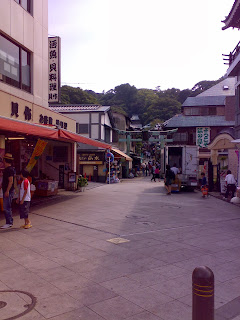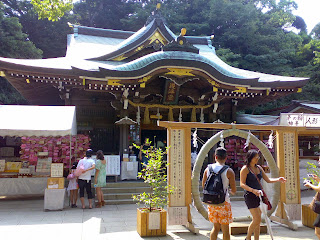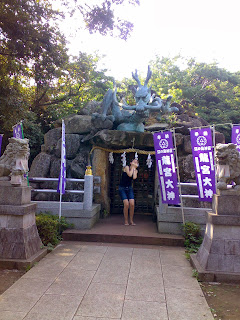Dopo lunghe trattative italo-giapponesi, decidiamo che la nostra festa in ufficio è da fissare per il 5. Mi incaricano di addobbare la sala per la festa. Amen. Per fortuna c'è già l'alberello super kitsch che ho preparato per Morana, con tanto di lucine a batteria, neve finta, palline e fiocchi rossi. Uno spettacolo per gli occhi!
Anche il nostro boss porta un albero..indovina chi lo deve sistemare? va bene, ci penso io, nessun problema. E il pomeriggio, un ventoso pomeriggio, mi viene la bellissima idea di innevare anche quest'alberello. Il vento si porta via ogni cosa e dopo aver consumato una intera lattina di neve spray, sull'albero rimane ben poco. Comunque sia, iniziamo il party tra festoni d'oro e argento (e rosa), fiocchi rossi e lucine colorate.
Tutti hanno portato qualcosa: io una bella torta al cioccolato, Morana un mix di dolcini e praline da leccarsi le dita (perchè se non ti lecchi le dita godi solo a metà, come recitava una nota pubblicità per snack salati), Kimura si è occupato di insalata, sangria e non ricordo cos'altro, poi abbiamo avuto il pane, finalmente pane serio, duro, croccante, non quello spugnoso da sandwich che ci propinano nei supermercati!!!E poi ancora torte salate, torte di mais, spumante..hhehe, il caro Jay ha portato, pensa te, uno spumante italiano....e che lo dico a fare!!E abbiamo anche preparato il gluh vein...con correzione!
A fare da contorno agli addobbi ci sta anche l'idea di portare dei cappelli da babbo natale, che io e Joost subito indossiamo senza timore. Subito i giappi si distinguono per la loro grande capacità a reggere l'alcol: dopo un paio di birre sono già a gironzolare per la stanza e fare brindisi a destra e a manca con tutti. Evviva lo spirito bacchico! Il povero Takeda poi, si impegna con molto entusiasmo nello spingere a bere rakjia, un tipico beveraggio croato sull'ordine del 38-40%, e pare ci trovi pure gusto. Alla fine della serata poi le decorazioni natalizie fanno da accessori moda e tutti si ritrovano a sfoggiare un fantastico fiocco o una collana di campane, ecc.....capite bene a questo punto della serata come ci si sia già devastati....
Altro fine settimana, altra festa di addio al vecchio anno: stavolta si festeggia con i compagni di allenamento, tali pallavolisti della Phoenix. Il sabato successivo alla devastante festa in azienda, ci si ritrova tutti assieme in un locale a Yokohama, seguendo la formula del "mangia e bevi a piu non posso". Dalle 18 alle 20 è un via vai di portate, un fantastico nabe (carne e verdure bollite in un brodo piccante e gustoso), birre a litri e umeshu (liquore di prugna, poco alcolico). Un giapponese mai visto durante gli allenamenti, ribattezzato 'lottatore di sumo mongolo', viste le dimensioni della testa e le proporzioni della panza, si preoccupa di impressionarmi. Al che io, col mio super elevato giapponese nella sua più aulica forma espressiva, l'ho mandato più volte a quel paese...poveretto, tanto ubriaco da non rendersi conto che lo stavo trattando coi piedi!!!
Ma i compagni di ventura incitavano lui a essere più insistente e me a essere più irritabile. E così fu. Nonostante gli sforzi di Morana a farmi conversare in giapponese con le ragazze, io mi rivolgo all'unico tizio che parla un pò di inglese e lui si accolla l'onere di fare da traduttore quando serve...spero solo non abbia tradotto male!!!
Dopo sole due ore di sbevazzamento, in mezzo alle quali chissà come chissà perchè ci entra pure la rakjia di Morana, beh, i giappi sono KO mentre io e MOrana, lallalla, fresche come delle rose. Dovendo lasciare il posto allo scadere delle due ore, ci dirigiamo verso un secondo posto per sbevazzare un pò di più, e lì davvero alcuni non ce l'hanno fatta e sono crollati nell'oblio dell'ubriachezza più totale e irreversibile.
Tutto sommato abbiamo riso tanto, abbiamo mangiato bene, abbiamo suscitato meraviglia (io con le mie conversazioni al cellulare in italiano con Valentina e Morana con i suoi capelli a turno tastati da tutte le ragazze), e abbiamo salutato tutti prima di mezzanotte.
Al rientro a casa, Joost e Eivind mi includono nel loro duo alcolico e si continua a bere e chiacchierare fino a mattina. E dopo questo secondo bonenkai (saluto al nuovo anno) mi pare che ne abbiamo avuto abbastanza. In questi giorni tutti i non giappi stanno rientrando a casa per trascorrere le feste in famiglia e gli istinti festaioli li lasciamo per il nuovo anno.
*************************************
December, time for xmas parties even in a country like Japan. After endless italian-japanese discussions, we decide that the party at the company is to be on 5th. I am in charge of decorating the room for the party. Amen. Fortunately there's already the super kitch little xmas tree i set up for Morana, with lights, fake snow, shiny balls and red ribbons. A show for the eyes!
Also our boss brings a tree..guess who has to decorate it? ok, I'll do that, no problem. And in the afternoon, a windy afternoon, I have the fantastic idea of snowing also this tree. The wind blows away everything and after using all the snow in the spray can, snow on the tree is very very few bits. Anyways, we start the party into a blast of golden and silver (and pink) decorations, red ribbons and colorful blinking lights. Everybody brought some food: me a chocolate cake, Morana a mix of cookies so good that you had to leak your fingers after eating, Kimura took care of the salad and the sangria, then Maeda cut the bread, finally serious real bread, not the gummy one, sandwich-like, from the supermarkets I have to eat every day!!!And also, salty cakes, corn cakes, sparkling wine....Italian sparkling wine from Jay. And we also cooked gluhvein with correction!! When I thought about the decorations i also thought about buying a couple of santa hats, which me and Joost wear with no fear.
Immediately the Japanese stand out thanks to their well known ability of (not) handling alcohol: after a pair of beers are already hanging around the room drinking with everybody with cheers and laughs. The poor Takeda also took seriously the drinking thingy and went to each one asking for a shot of rakjia, typical croatian drink with 38-40% of alcohol...at the end of the party the decorations for the room became beauty accessories for ourselves, so you can guess at this point how far they went with the drinking...
Another weekend, another party: this time we celebrate with the training people, the volley guys of Phoenix. The Saturday after the smashing party at the office, we gather in Yokohama and go to a place with all-you-can-drink/all-you-can-eat formula. from 6 to 8 pm is a come and go of dishes, a fantastic nabe (meat and vegetables boiled in a spicy yummy soup), beers in litres and umeshu (plum liqueur). A Japanese dude I never see during practice, renamed 'mongolian sumo wrestler' because of the huge head and the huge belly, he's busy with trying to impress me. So I, using my high level Japanese in its highest polite expressive forms, I sand him to f*** off....he was so pissed drunk that he didn't take it seriously and didn't understand!!
But the fella pushed both him to be more annoying and me to be more annoyed. And so it was. Morana pushed me to conversate in Japanese with the girls, but I prefer to express my self in English with the only guy who could understand and takes the duty to translate for me when needed....I only hope he translated correctly!!!
After only two hours of drinking, with some rakjia suddenly appeared from somewhere somehow, the Japanese are KO, while me and Morana are still as fresh as a rose. The deadline pushed us to leave this first place and head to another drinking place to get drunk a bit more and there some of us really didn't make it and fell into the total and irreversible oblivion.
All in all we had fun, we ate and we raised wonders (me with my conversation in Italian over the phone with Valentina and Morana with her hair being touched by all the girls) and we left before midnight.
Back home, Joost and Eivind lured me in their alcoholic duo and drag me into some more drinking, so we keep drinking and chitchatting till morning. And after this second bonenkai (greetings to the new year) I guess we have had enough. In these last days all the non Japanese are going back home to spend the holidays with the family, so we save our party instincts for the next year.





















